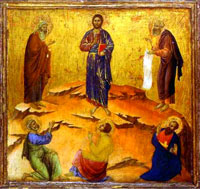How To Begin
• Go to your holy place.
• Spend some moments settling down. Use whatever ways you have learned to center yourself. Let the spine be straight, the body relaxed and alert. Let your body be firmly planted on the earth, your hands resting easily, your heart soft, your eyes closed gently. Bring awareness to your body. Consciously soften any obvious tension. Notice your breath. Notice your feelings and thoughts. Let go of any habitual thoughts or plans.
• Remember your desire for God in the form of a prayer or wordless feeling.
Continue with A or B or C:
A. A Form of Centering Prayer
• Let a short word or two rise from deep in the center of your being that expresses your desire or your love for God. Don’t try to force the word(s) to come. Just listen for it with a relaxed, inviting mind.
• Silently and gently repeat the word(s) in rhythm with your breathing. Enter the present moment. Stay awake. Let your intent be to fall effortlessly through that word into God’s spacious, wordless presence. . .Let the word breathe through you. . .You may begin by actively repeating the word, but eventually you may find yourself simply listening to it, as you would to a bell that is ringing far away. . . As your mind becomes quiet, you may find that the word changes slightly–it may become shorter, or sound more softly–or it may simply fall silent, as you open to the presence of God. Let that happen, if it does. . . Sometimes you may need to use an act of will to repeat the word, just as a bird sometimes needs to flap its wings. Sometimes you may find yourself simply resting in the presence of God without using the word, just as a bird sometimes glides through the air. . .
• Whenever you become aware of anything else–if anything distracts you or pulls you away from your quiet awareness of God, then very gently use the prayer-word to return to the Presence. . .Seek nothing during this time but steady, trusting, attentive rest in God.
• Conclude the time of prayer by slowly praying a verbal prayer (such as the Lord’s Prayer–or “Glory to you who creates us, redeems us, and lives in our hearts, now and forever”–or a spontaneous prayer of your own).
B. Lectio Divina (Sacred Reading)
Lectio
• Take up your Bible. Select a passage. Read aloud (if possible), attentively and reflectively, until a word, phrase, or scene catches your imagination or heart. At that moment, pause, put your Bible aside, and give yourself to prayer. . .(Note: Each step may last only a moment, or may extend over several minutes. Take the suggested steps as guidelines only. You may find yourself moving back and forth between steps, or praying in a different sequence. That is fine. Pray as the Spirit moves you.)
Meditatio
• Gently repeat the word or phrase over and over. Mull on it. Reflect on its meaning. Let the words sink into your heart and mind. Chew on them, as a cow chews its cud. Savor and relish them.
Oratio
• When you feel saturated, share your feelings with the Holy One in whose presence you are. As you take in the insights you received during the meditatio, what is your spontaneous, emotional response? Share your responses–with words, song, feelings or movements of the body–with God. Return to quiet, and listen for God’s response to you.
Contemplatio
• Quietly rest in God’s presence. You are lovingly present to one another.
• When attention falters, pick up your Bible and resume reading until the next moment of insight or movement of love.
• Continue this peaceful, unhurried rhythm of reading and pausing.
C. Ignatian Contemplation
(adapted from Martin Smith, The Word is Very Near You)
• Ask God to touch you through the passage of Scripture you have chosen. Tell God that you desire to be open to the word, the healing, the probing, the consolation, whatever God knows you need at this time.
• Pick up your Bible and read the passage slowly and carefully several times. Pause between each reading for half a minute or so, to allow yourselves to notice details. Let questions and insights occur as you notice more with each reading.
• Place the Bible aside. Now give your power of imagination free rein to bring the scene to life with yourself as a participant. Don’t look on it as if it were a movie projected onto a screen. It is happening all around you. Feel free to smell the scents of seashore and marketplace. Hear the noises, sense the movements. Allow yourself to become whoever you want in the scene. For example, are you one of the disciples? A bystander able to see everything happen right there on the spot? Are you the sick person? Are you Jesus?
• Let the drama slowly unfold. Let whatever happens, happen. Don’t control the story. Let yourself feel what happens. Don’t step back out by trying to glean lessons from the story (or to take notes for a sermon!). Don’t start thinking about applications to your life. Allow yourself to be affected by the words and actions of the story.
• As your feelings are affected by the event, let yourself respond. Often you need to respond by articulating these feelings to Jesus. Tell him how you have been touched. Ask him what the feelings mean. What kind of gift are they? What are you thankful for? What do you want to ask for? Who is God for you just now? How is God inviting you? At other times the best response is to stay with the impression the story has had on you, savoring it and soaking yourself in it, aware of the presence of Christ.
• When the awareness dies down of itself, or you feel you have replied and responded to God’s way of touching you in this particular prayer, bring the meditation to a simple conclusion, perhaps by reciting a prayer such as the Lord’s prayer or by singing the verse of a hymn. (It is better to round off the prayer time positively, so you can resume your activity, rather than just let the prayer peter out into distraction and restlessness.)
At the end of your prayer, after A or B or C:
• Give thanks to God.
• Shift your posture. You may wish to bow, as a gesture of gratitude and respect. Take a few minutes to get in touch with what you were feeling, sensing, or intuiting in the course of your prayer.
• Note in your journal exactly what you were feeling, sensing, or intuiting.
Two good, basic books on prayer:
Nancy Roth, The Breath of God: An Approach to Prayer, Cambridge, MA:
Cowley Publications, 1990.
Martin L. Smith, SSJE, The Word is Very Near You: A Guide to Praying with Scripture, Cambridge, MA: Cowley Publications, 1989.
And a book on contemporary theology:
Marcus J. Borg, The God We Never Knew: Beyond Dogmatic Religion to a More Authentic Contemporary Faith, SanFrancisco: Harper-SanFrancisco, 1997.
(Extracted from a lovely little book on kinds of prayer that emerge from Jesus’s crucifixion. See Margaret Bullitt-Jonas’s, Christ’s Passion, Our Passions, Cambridge, MA: Cowley Publications, 2003).

